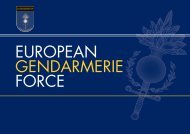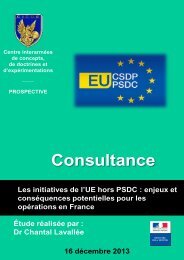Conference
science-research-bulletin-2013-conference
science-research-bulletin-2013-conference
You also want an ePaper? Increase the reach of your titles
YUMPU automatically turns print PDFs into web optimized ePapers that Google loves.
EUROPEAN POLICE SCIENCE AND RESEARCH BULLETIN<br />
SPECIAL CONFERENCE EDITION<br />
The extent of the crime reduction in England and<br />
Wales is shown in Figure 2 below. It covers the<br />
period 1918-2013 for comparison with Figure 1.<br />
(n.b. The changes from 1999-2003 approximately<br />
are caused by changes to the counting rules and<br />
shift to measurement by financial year.) Figure 2<br />
illustrates not only the prolonged increase in crime<br />
but also the dramatic reductions in more recent<br />
years.<br />
A systematic review of problem oriented policing<br />
has also shown the approach to be effective when<br />
implemented at local level (Weisburd, et al, 2010).<br />
For example, the Goldstein Awards in the USA or<br />
the Tilley Awards in the UK are presented on an<br />
annual basis to local police or partnerships who<br />
have demonstrated reductions in policing problems<br />
using the SARA process. These initiatives are carried<br />
out by staff who have tackled local problems and<br />
learned from the process. Descriptions of successful<br />
projects are available on the website www.<br />
popcenter.org which includes all the Goldstein<br />
and Tilley winners but also a significant number<br />
of research reviews on how to deal with highly<br />
specific problems such as robbery at automatic<br />
teller machines or prostitution in motels.<br />
It is important to note that it is not the systematic<br />
application of the SARA process that reduces<br />
crime but the results of that process. The correct<br />
identification of the problem, the creative analysis<br />
of the data and the introduction of the appropriate<br />
mechanism in the relevant context lead to the<br />
outcome of crime reduction. The mechanism is<br />
the ‘active ingredient’, the means through which<br />
the presenting problem is reduced. At present we<br />
know of five mechanisms, which, either singly or<br />
in combination, might reduce crime in a given<br />
context. These are intended to affect the decision<br />
making process of the potential offender and have<br />
been described by Clarke and others as: Increasing<br />
perceived risk, increasing effort, reducing rewards,<br />
reducing provocation or removing excuses (see for<br />
example, Clarke and Eck, 2003).<br />
The challenge for the would-be crime preventer<br />
is to introduce initiatives in response to defined<br />
problems within specified contexts which fire<br />
those mechanisms, and thus lead to a change in<br />
the outcome – i.e. a reduction in crime. So, for<br />
example, in certain circumstances the introduction<br />
of CCTV might lead to a reduction in crime because<br />
the risk of offending was seen to have increased<br />
(capture is perceived as more likely) and/or the<br />
effort was increased (e.g. the offenders had to find<br />
an alternative location which they believed was<br />
not overlooked by active camera systems and thus<br />
decided to ‘give up’.)<br />
4. FUTURE DEVELOPMENTS<br />
Much of this is not new. There are many smallscale<br />
evaluations of locally based initiatives<br />
available on specialist websites such as the US<br />
POP Center website, or systematic reviews of what<br />
research has shown to work, such as the Campbell<br />
Collaboration (see www.campbellcollaboration.<br />
org) or crime solutions (www.crimesolutions.gov).<br />
Many of these activities are supported by central<br />
governments such as the US Justice Department<br />
or the Home Office in the UK but the ‘take-up’<br />
by the police has tended to be patchy and to be<br />
dependent upon the interests of individuals rather<br />
than being part of the corporate culture of the<br />
police. There is now, however, a growing appetite<br />
amongst governments to encourage the police<br />
(and other professionals) to base their decisions<br />
upon established bodies of evidence rather than<br />
treating the task as a craft-based exercise, which<br />
can be learned from experience alone. This is to<br />
some extent being driven by the economic need<br />
to maintain the recent reductions in crime against<br />
a backdrop of reduced public sector resources.<br />
To strengthen this approach the UK Government,<br />
for example, has established six ‘What Works’<br />
Centres covering various aspects of public policy<br />
including crime reduction. The What Works<br />
Centre for Crime Reduction is based at the new<br />
College of Policing, which is specifically remitted<br />
(inter alia) to identify, develop and promote good<br />
practice based on evidence. This What Works<br />
Centre is supported by a £3.2m investment from<br />
the Economic and Social Research Council and<br />
the College itself, which is to fund a consortium<br />
of eight universities across the UK. Over the next<br />
three years the Consortium members, working<br />
with advisors from other universities around the<br />
world will carry out a series of systematic reviews<br />
of what works in crime reduction to inform both<br />
policing and the work of other agencies with an<br />
interest in or remit to address crime reduction.<br />
In addition to carrying out the reviews the<br />
programme is to include the development of a<br />
pilot training programme for the police in the use<br />
of the resultant material and the interpretation of<br />
research evidence more generally.<br />
All this is not to deny the relevance of experience<br />
and individual expertise in, say, acting as a<br />
126





